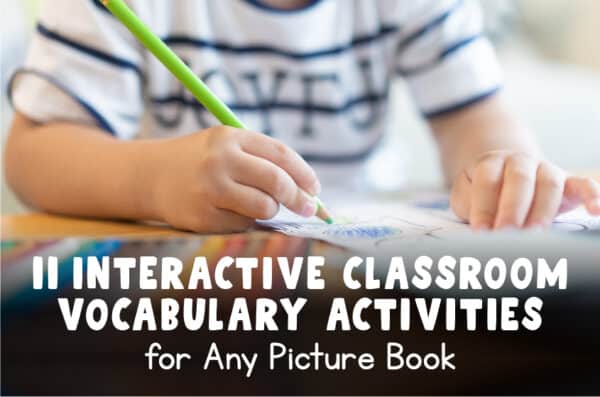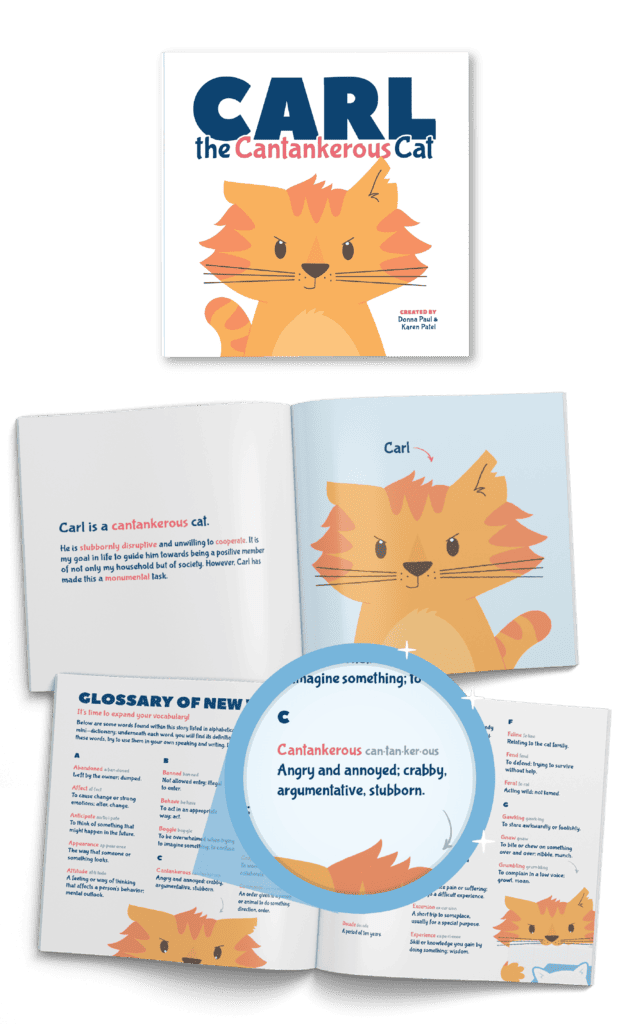Classroom Vocabulary Activities: 11 Exciting Post-Picture Book Reading Ideas
Are you looking for classroom vocabulary activities? Then you’re in the right place!
We put together a list of vocabulary-boosting activities you can use with the elementary-aged learners in your life after reading any picture book.
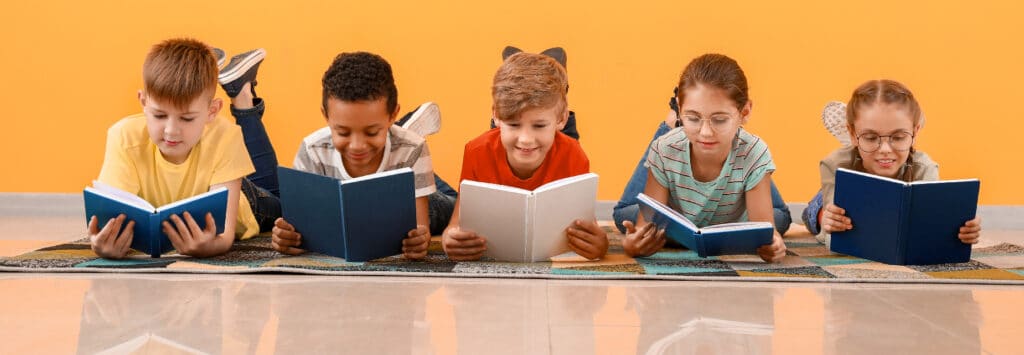
As a Montessori teacher, I believe wholeheartedly in the magic of picture books. I always recommend them as summer reading activities for elementary students, but they offer so much more.
Picture books teach readers of all levels by showing words with pictures, making it easier to understand. They let kids see a story and this helps them remember different words by making visual connections.
💡 You’ll love these vocabulary development activities for elementary!
Classroom Vocabulary Activities with Carl
While the following list of engaging classroom vocabulary activities is designed to enhance learning with any picture book, we’ve chosen our self-published picture book Carl the Cantankerous Cat as the exemplar.
😼 Carl the Cantankerous Cat
isn’t just a story – it’s a teaching tool hidden within fun!
This picture book spans over 30 pages with 70+ advanced words highlighted and defined in a glossary. Featuring captivating illustrations and 2 pages of follow-up activities, it’s a must-have on any elementary bookshelf.
Find it on Barnes & Noble and Amazon!
To provide students in the second plane of development with an enriching and empowering learning experience that will last a lifetime give some of these classroom vocabulary activities a try with Carl the Cantankerous Cat, or any picture book!
📚 Looking for picture books to boost elementary-level vocabulary?
Explore our collection of 31 Captivating Picture Books, carefully curated for 5th graders! Also, check out our list of fantastic money books for kids!
11 Classroom Vocabulary Activities to Try After Reading a Picture Book
Explore these fun vocabulary activities for elementary students after reading any picture book.
1. Use a Vocabulary Graphic Organizer
Graphic organizers have always been a regular part of my upper elementary students’ learning routine.
They are a fantastic way to help students really dive into the words they are reading, and they can be made to be really fun. In a way, students turn into word detectives as they work to uncover the tasks on the organizer. As a result, their understanding of the word gets a boost, and their thinking skills get sharper.
What makes vocabulary graphic organizers a go-to for my learners is their versatility. You can use them across different subjects, acting as bridges to expand vocabulary and enrich post-reading learning.
Our engaging self-published picture book, Carl the Cantankerous Cat, is a perfect match for any graphic organizer. It comes with a glossary bursting with over 70 advanced words! With this book, students have a variety of words to explore and understand.
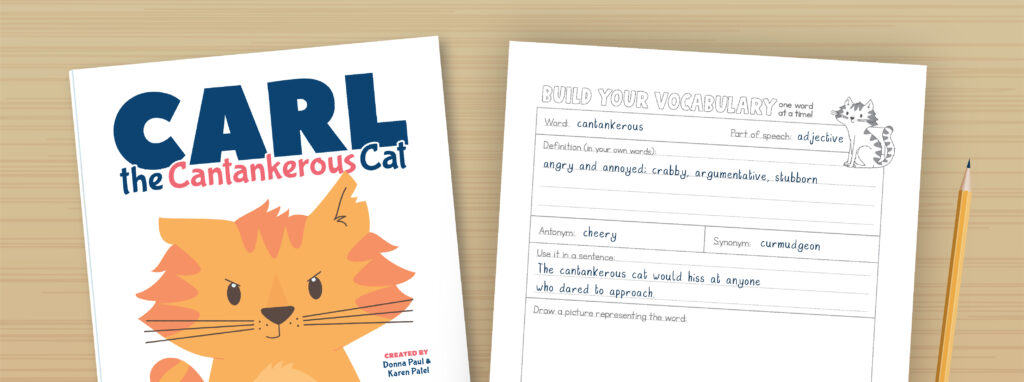
💡 Teacher Tip: Encourage word discover with graphic organizers!
Provide your students with graphic organizer worksheets while exploring a picture book. Prompt them to identify unfamiliar words in the story. Once they pick a word, they’ll use the organizer to learn more about it. Encourage them to build a word list using these printable organizers.
You can empower your students’ language skills with vocabulary graphic organizers.
😼 Check out our engaging Vocabulary Graphic Organizer designed for elementary students!
Immerse your students in the engaging graphic organizer packed with engaging tasks on a single page. It’s a surefire way to spark curiosity and enhance your students’ grasp of words!
This resource encourages students to get to know the words they encounter while reading.
Get this vocabulary graphic organizer now! Your students’ linguistic growth awaits. Click here to PURRR-chase!
2. Sentence Bee
Think of it as a fresh spin on the classic Spelling Bee but with a creative twist.
Introducing the Sentence Bee, a captivating activity designed to boost vocabulary skills for students. And while I’m a self-proclaimed classroom spelling bee enthusiast myself, the sentence bee has sparked something in my students that no spelling bee can compete with!
Instead of spelling words, in a sentence bee students show off their smarts by using assigned words in complete sentences.
Want to organize a classroom sentence bee with your elementary learners? It’s pretty straightforward.
Provide students with a list of words to become familiar with because on the day of the sentence bee students will be assigned different words from that very list to make a sentence with. The idea is that students showcase their understanding of words and their meanings by using the words properly in complete sentences. 🐝
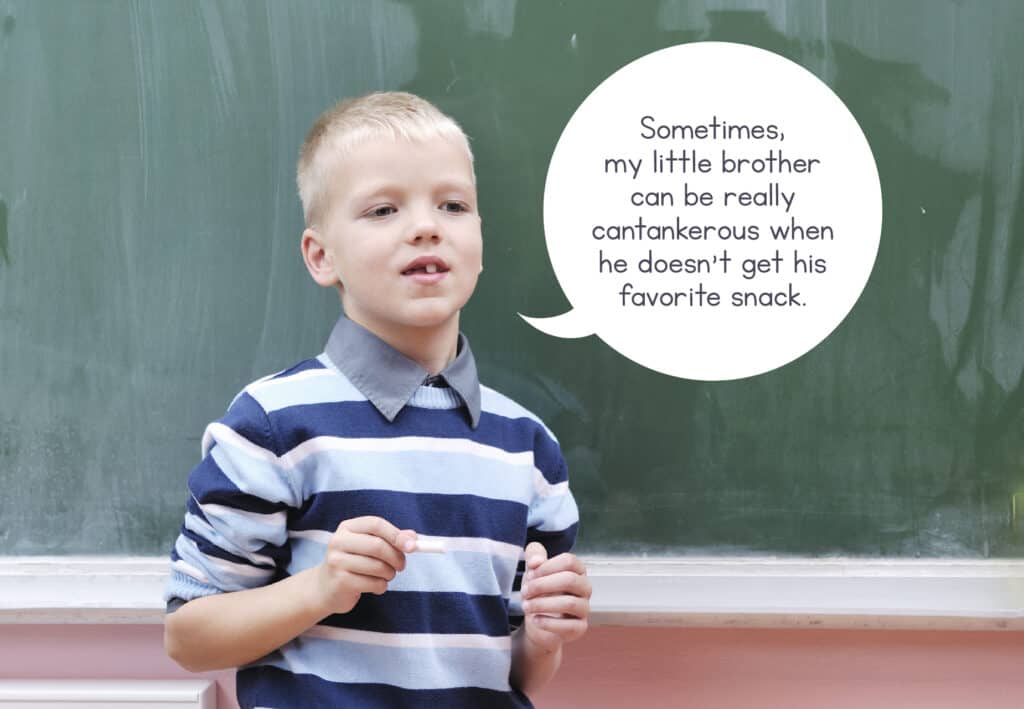
🔡 Teacher Tip: Elevate the excitement with themed sentences!
Take your sentence bee to the next level by challenging students to stick to a particular theme when crafting their sentences.
For instance, they could be tasked with creating sentences related to historical events, travel destinations, or fascinating animals.
By combining fun and educational elements, a sentence bee ignites language skills and fosters a deeper understanding of vocabulary for elementary students.
If your learners are using Carl the Cantankerous Cat for this classroom vocabulary activity, they can refer to the Glossary of New Words at the back of the book to find words to use in the sentence bee or they can flip through the book and pick words for themselves. Students might want to use graphic organizer worksheets to get to know and review the meaning of the words they may encounter in the classroom sentence bee.
Not using Carl the Cantankerous Cat for this classroom vocabulary activity? No problem! Work with your learners to choose some words from the picture book they are reading. Words that they don’t know or kind of know but can’t explain. These are also words they can explore with a vocabulary graphic organizer.
⚡️ Prepare Them in Advance!
Whether in the classroom or at home, informing kids about an upcoming sentence bee is crucial. Consider a trial run to help them understand and prepare for this thrilling challenge.
This preparation boosts confidence and enthusiasm among participants, encouraging them to dive into studying those vocabulary words!
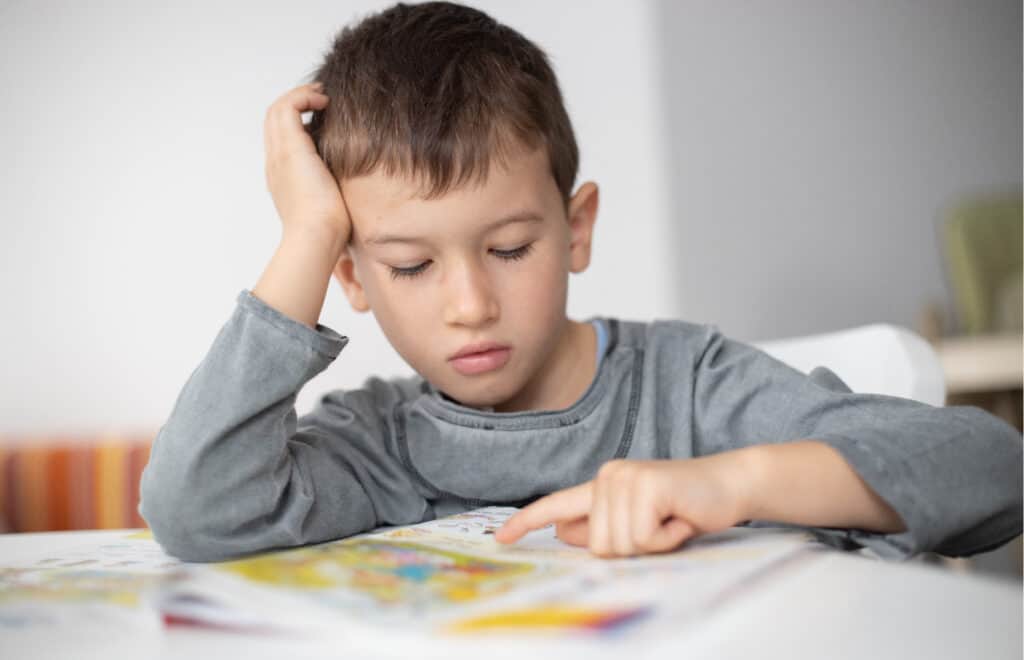
💡 Teacher Tip: For this to be a vocabulary victory, students need to really know their words. Cue study sheets!
Whether you’re using Carl the Cantankerous Cat or another picture book, I suggest encouraging your students to create their own study sheet that they can use to review word meanings and refer back to for sentence building. It may include a series of vocabulary graphic organizers kept in a duo-tang, words used in sentences written on cue cards, or a well-laid-out chart on the computer Whatever works for them.
Their original study sheet would ideally include a preselected number of words, I like to challenge my students to make a list of 10 words to start, as well as the definition, part of speech, and some synonyms of the word.
By creating a personalized glossary, students not only enhance their understanding of each word but also create a valuable tool to aid in remembering and recalling new vocabulary.
💡 Bonus Idea!
Kids in the second stage of development thrive in group settings, so it’s valuable to let elementary-aged children collaborate in small groups with their peers.
Post-picture book reading, have students team up to compile a list of words suitable for a classroom sentence bee. Working together, they’ll gather uncommon, intriguing, and even amusing words. You might do the same to expand your word options!
Once each group has 5-10 words, gather everyone to share their lists. As a unified class, craft an official list for your classroom sentence bee. Now, learners can create study sheets to prep for the event.
3. Dramatic Monologue
Discover the excitement of dramatic monologues, but first, let’s talk about what a dramatic monologue is!
Breaking the word down, ‘mono’ means single, while ‘logue’ refers to speech. In simple terms, a monologue is a spotlight moment where a character steps forward and pours out their feelings, sharing tales, or simply letting loose their inner thoughts.
Invite students to craft a dramatic monologue from Carl’s perspective – maybe an encounter he had with the squirrel from the picture book or Carl pleading for more food in his dish. Let them choose a scene that they connect with.

🎭 Teacher Tip: Help Them Take Center Stage with Monologues!
As an educator, you can spark their imagination and nurture budding actors. Encourage students to step onto the stage confidently, embody characters enthusiastically, and add their own flair to their monologues. This not only hones their acting but also nurtures self-expression, empathy, and a lasting passion for performing arts.
If you’re using a different picture book, let students pick a standout moment or an oh-so-revealing scene that captures the heart of the main character. A captivating dramatic monologue can flourish from there!
This classroom vocabulary activity, sparked by Carl the Cantankerous Cat, is here to let imaginations run wild and language skills soar. Are your elementary-aged learners ready for the spotlight?
4. Write a Postcard to the Main Character
A postcard is a rectangular piece of thicker stock paper intended to be written on and mailed without an envelope.
What would your elementary-aged kids want to say to Carl the Cantankerous Cat? Maybe a riddle for him to ponder, a hilarious joke to tickle his whiskers, or simply pouring out their love for dogs – who knows where their creativity will take them!

Give your students the chance to connect with Carl the Cantankerous Cat with this language activity!
Don’t worry if Carl’s not on the radar for your learners at the moment. You’ve got options! Use the picture book that’s capturing their imagination currently, and let them craft a postcard to the main character of that story.
📮 Teacher Tip: Use postcard templates or let students design their own.
Remind students about a postcard’s features: one side for the recipient’s address, a short message, and a stamp – a mini canvas for sharing thoughts and experiences!
But the real magic happens on the flip side! They can include a captivating picture, a delightful drawing, or even an intriguing diagram to tell a story. This activity deepens students’ understanding of communication types and makes learning fun!
5. Write a Book Review
I use this classroom vocabulary activity as a chance for students to express their thoughts using a variety of words so that they can paint a vivid picture of what they read.
When writing a picture book review, children get to expand on details about the characters, and the captivating setting, sharing a glimpse into the heart of the story. But most importantly, it’s their moment to unveil their genuine thoughts about the book.
✏️ Want to read more about writing book reviews for kids?
Writing book reviews is just one of 31 Fun Summer Reading Activities Elementary Students Will Love we have curated for you. Check it out!
Guide students to express opinions confidently, back them with details, and rate books like Carl the Cantankerous Cat – how many stars and why?
Encourage writers to use vocabulary words they learned from reading the book in writing the book review. Take it a step further and have them find synonyms for newly learned words. Now they’ll have even more terms to express themselves accurately.

Check out this enthusiastic young book reviewer as he dives deep into the hilarious and relatable adventures of Greg Heffley in his review of Diary of a Wimpy Kid.
6. Acrostic Poem
Both reading and writing poetry are excellent ways to stretch vocabulary.
If you’re looking for a simple yet entertaining poem to introduce to your young learners, you have to try acrostic poems. This is for sure one of my student’s favourite engaging vocabulary activities.
An acrostic poem is a creative form of poetry where the initial letters of each line when read vertically from top to bottom, spell out a word, name, or message related to the poem’s subject.

Each line of the poem begins with a word or phrase that corresponds to a letter in the chosen word, resulting in a clever and visually engaging composition.
Start simple by having students write an acrostic poem using the name of the main character of their book. If they’re using our picture book for example, they start by writing the letters C-A-R-L vertically down the page and then come up with a word, phrase, or complete sentence that starts with each letter to describe different aspects of Carl.
Here’s an example using ‘Carl’:
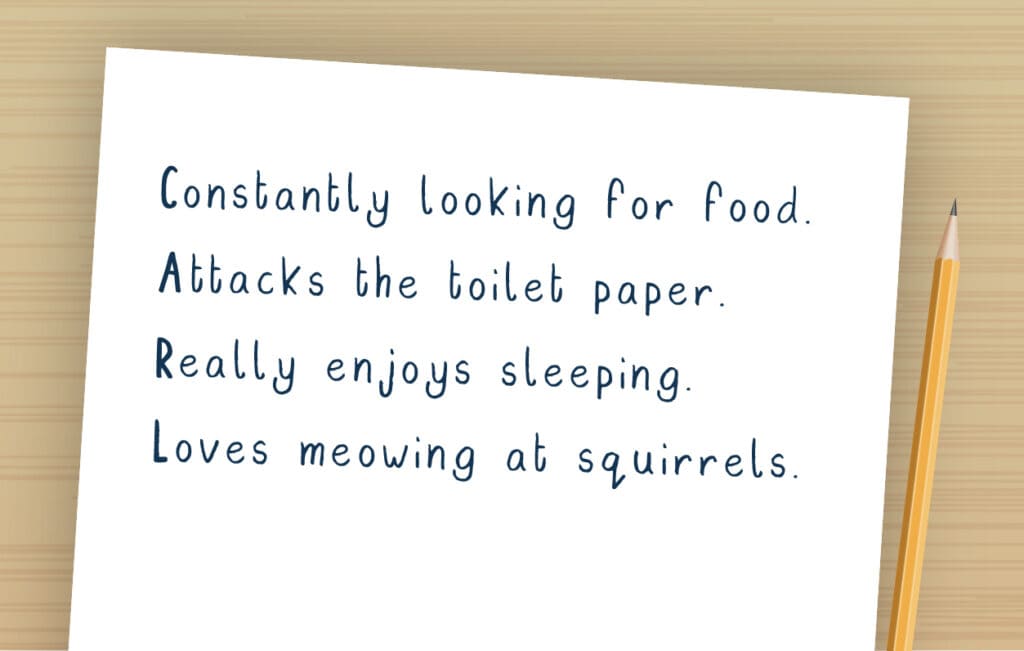
😼 Teacher Tip: If your learners are looking for more of a challenge, have them use bigger words and not just names. Have them choose two or three more words from the picture book they read to make acrostic poems with.
For example, they could create a poem with each letter in the word CANTANKEROUS CARL to make sentences about Carl’s crabby behaviour.
7. P.S. – Write an Epilogue
An epilogue is a final section after the main part, often summarizing what becomes of the characters in a story. It is always set at some point in the future after the main events of the story have taken place.
Sometimes an epilogue is used to hint at the next installment in a series of works. Exciting!
Invite students to become storytellers and authors in their own right. Prompt those curious minds to craft an epilogue for the picture book they’ve recently finished reading. Have them explore what will happen next to the main character.
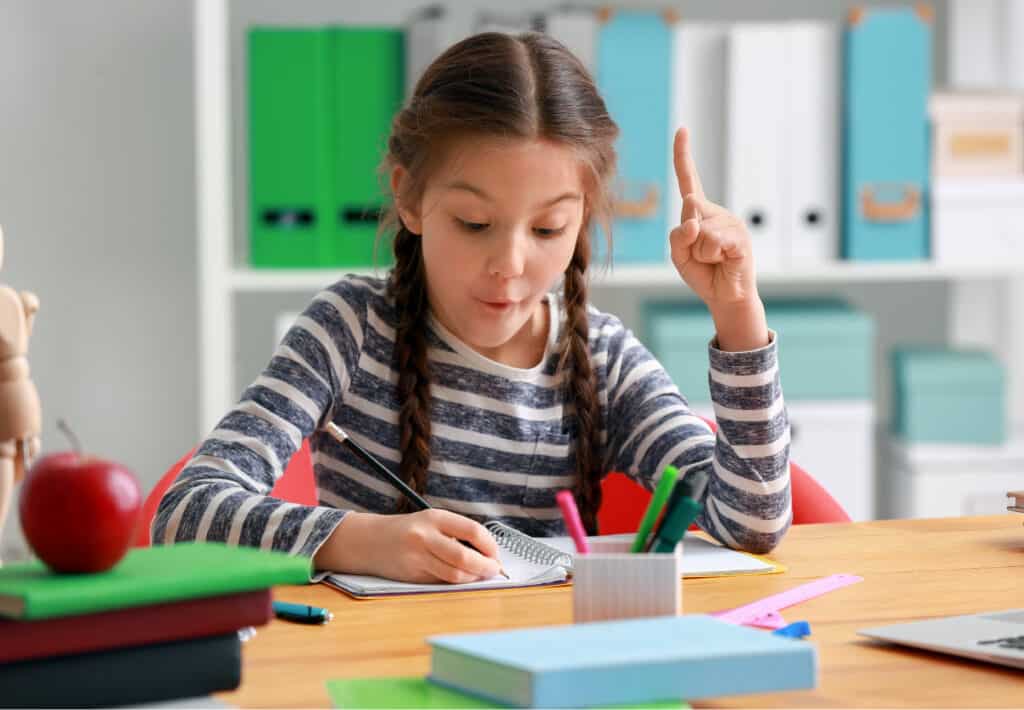
For example, they may ask themselves what new adventures await Carl. What challenges will he face, and what victories will he achieve? Who will he meet next? Will he ever learn to be less cantankerous?
Epilogues are special – they peek beyond the final page, hinting at future adventures or providing closure. They’re a charming addition to vocabulary activities for elementary students.
8. Shades of Meanings Book Title Activity
Similar to colours, words have different shades as well. These are called shades of meaning.
Also known as synonyms with nuanced differences, shades of meaning guide us in expressing our thoughts and emotions accurately. They empower us to select the perfect words for our writing.
Ask your students what their favourite colours are. Blue? Yellow? Green? Whatever it may be, that particular colour has multiple different shades.
For example, the colour green could be broken down into lime green, jungle green, or crocodile green, just to pinpoint a few of many.

With this in mind, task students with coming up with five shades of meaning for some of the interesting words they’ve come across in a picture book they’ve read. For example, for the word cantankerous they could use words such as disagreeable, stubborn, quarrelsome, irritable, and grumpy.
Now that they understand what shades of meaning are, it’s time to let their creativity flow!
Using shades of meaning, have students come up with three different book titles for the picture book they read.
Perhaps our picture book should have been titled Carl the Irritable Feline, or maybe we should have called it My Prickly Pet, Carl? Not as catchy, but a clever example of shades of meaning, wouldn’t you agree? See, these classroom vocabulary activities are fun!
🖍️ Teacher Tip: Don’t just stop with the book title!
You can keep the learning going with this engaging classroom vocabulary game by encouraging kids to create their very own original book cover to go along with the new book title.
By expanding their linguistic horizons and exploring their artistic talents, students not only enhance their vocabulary but also bring literature to life in the most delightful and creative way.
9. Create an Ongoing Glossary of New Words
Inspire young readers by guiding them to create their own glossary of new words – their very own living lexicon!
Encourage elementary-aged kids to maintain a word journal for a day, a week, a month, or even an entire term. Whenever they encounter an intriguing new word, it earns a place in their journal.
Their mission? Unearth the word’s meaning, determine its part of speech, collect a handful of synonyms, and write a sentence that captures the essence of the word.
💡 Teacher Tip: Enhance your language lessons with engaging videos!
Refresh your students’ understanding of the parts of speech by exploring our curated collection of educational and entertaining videos in the blog Parts of Speech Videos for Your Elementary Language Lessons.
Here’s an example of the glossary in our Carl the Cantankerous Cat picture book:
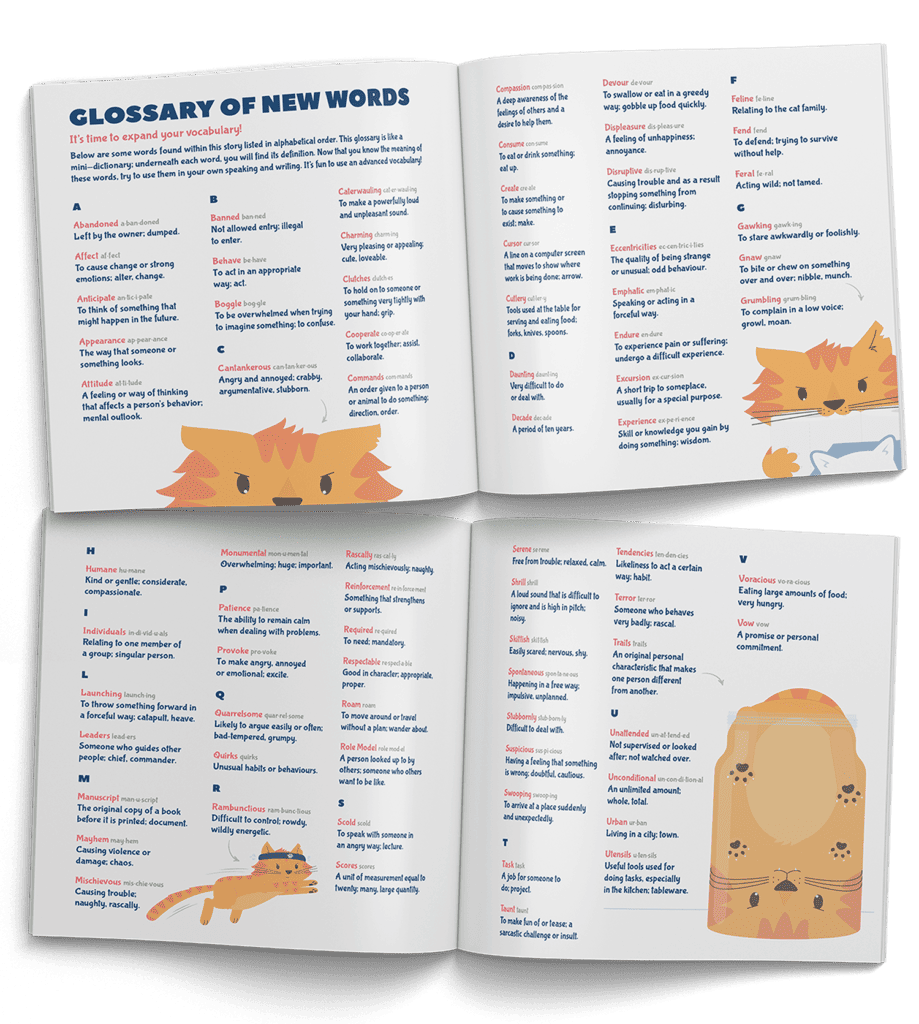
This classroom vocabulary activity lets students explore words from books, signs, instructions, and even video games they encounter, collecting treasures along the way.
As they define, describe, and play with words, they’re not just learners – they’re word wizards!
🔤 Teacher Tip: Spruce up your elementary classroom’s vocabulary!
Check out our Word of the Week activities!
Our engaging, ready-to-use vocabulary-building products are designed to infuse excitement into learning by introducing elementary students to captivating words.
Perfect for expanding any young learner’s lexicon, these vocabulary development activities promise an enriching journey into the world of words.
10. A Historical Adventure
Take a step back in time with a picture book character.
Have students imagine whisking the main character of a picture book they read into another historical era, infusing their presence with importance and grandeur. The result? An unfolding adventure that seamlessly blends words, history, and boundless imagination, crafting an unforgettable story-writing experience.
For example, have students transport Carl the Cantankerous Cat back in time to the intriguing world of Ancient Egypt and write a story about what his life would have been like in that era. The aim here is to fuse vocabulary enrichment with imaginative writing and the study of history.

This classroom vocabulary activity is filled with learning opportunities as students first need to do a bit of research to gain an understanding of the feline’s role in Ancient Egypt’s history. When they have a grasp on the historical setting, get them to imagine Carl thriving in the land of pharaohs and pyramids.
💡 Teacher Tip: Highlight key vocabulary words.
To enrich their narratives, encourage students to use vocabulary words related to the topic, in this case, of Ancient Egypt.
Words such as ‘pharaoh’, ‘pyramid’, ‘sarcophagus’, and ‘hieroglyphics’ would be great words to highlight from this period of time.
Now it’s time for them to draft a short story about Carl’s escapades in this ancient civilization. Through peer and teacher reviews as well as final edits, students can polish their stories.
This vocabulary game for the classroom can culminate in students sharing and discussing their imaginative tales, enabling them to reflect on how using vocabulary related to a specific time period can really enhance storytelling.
11. Paper Bag Book Report
This is one of my favourite interactive vocabulary activities for elementary students and involves multiple layers of exploration, from the external presentation to the internal representation of the story.
And all that is needed to make this happen is a paper lunch bag, something to write and draw with, as well as a bit of creativity and imagination (and maybe some random objects lying around).
Students will begin by drawing a captivating title page on the front of the paper bag, visually capturing the essence of the picture book they just read. On the back of the bag, they will write a short outline of the story, highlighting important events and the main character’s journey.

Students will use one side of the bag to list five adjectives that describe the main characters personality, allowing them to explore words to pinpoint their complexities.
On the opposite side of the bag, they will articulate the story’s core message, whether it’s about empathy, friendship, or another theme discovered in the narrative. This is essentially the moral of the story.
The heart of this book report idea lies within the bag itself. Literally!
Students will come up with 6-8 items that symbolize key elements from the picture book and put them inside the paper bag. These could include drawings, small props, or cutouts that represent characters, objects, or significant moments from the picture book they read.
For the book Carl the Cantankerous Cat, students may put a square of toilet paper in their paper bag. They might also put a sock in there, a cat ID tag, or even some cutlery. These are all items that are referenced in the story and hold significance to the reader.
With their bags assembled, students will have the chance to present their paper bag book reports to their peers. This presentation not only showcases their understanding of the story but also encourages them to express their creative choices and interpretations. Following each presentation, class discussions will unravel diverse perspectives and insights, fostering critical thinking and collaborative learning.
The beauty of the paper bag book report? It’s a fun classroom vocabulary activity that can be used with any picture book.
Learning is Made Fun with Classroom Vocabulary Activities!
So there you have it. You now have more than enough interactive vocabulary activities to keep your elementary-aged students (middle school kids can join in on this fun too!) entertained and learning with picture books.
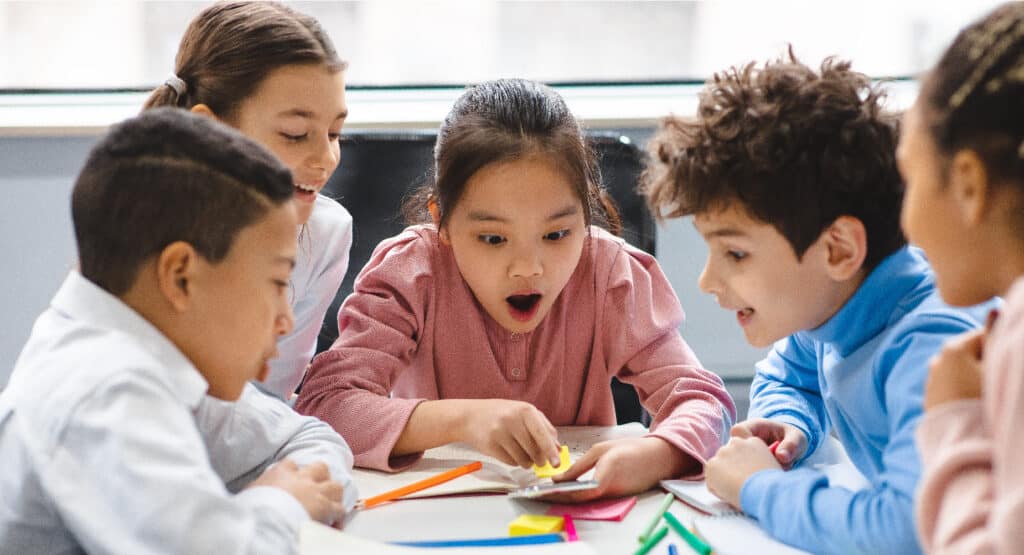
Consider adding some of these vocabulary games for the classroom to your teaching toolkit. They hold the key to unlocking a world of enjoyment and learning, ensuring your students thrive with every turn of the page.
Pairing Vocabulary Activities with Picture Books Adds Value
From my experience in the classroom, I can confidently say that reading picture books is a great way to expose elementary learners to new words and consequently expand their vocabulary.
Picture books serve as exceptional bridges between children and learning. They provide a multitude of opportunities to easily intertwine education into a fun and captivating experience.
In their enjoyment, each page provides a visual connection with the words being read, offering a contextual backdrop and creating valuable opportunities for teachable moments.
By seamlessly weaving interactive vocabulary activities into their reading routine, you can amplify the fun factor while solidifying connections to learning.
When paired with picture books, classroom vocabulary activities:
💬 Expose students to uncommon words;
💬 Enhance their communication skills;
💬 Boost reading comprehension;
💬 Improve writing abilities;
💬 Expand conceptual understanding;
💬 Increase confidence;
💬 Cultivate a love for language;
💬 Prepare children for academic success;
💬 Inspire young readers to want to read more.

I’ve witnessed firsthand how coupling picture book reading with engaging vocabulary activities can revolutionize the way students explore stories and absorb language.
When students enjoy learning through picture books, the knowledge they gain sticks with them. After reading, fun vocabulary activities make what they’ve learned memorable and encourage them to use new words in everyday conversations. It’s learning in disguise!
Maximize Elementary Learning with Vocabulary Activities
Incorporating classroom vocabulary activities is a dynamic way to elevate elementary students’ verbal and communication prowess.
These activities captivate students, infusing excitement and engagement. From my perspective, they serve as potent tools for fostering word retention and reading application.
Making word exploration enjoyable, through fun activities like rebus puzzles and scavenger hunts, not only holds student interest but also refines their comprehension of new vocabulary. This is what we like to call learning in disguise!
Recent studies highlight the positive effects of exciting activities, like games, on student engagement and willingness to face challenges. Activities used to enhance learning have a special power – they make learning fun and keep students focused.
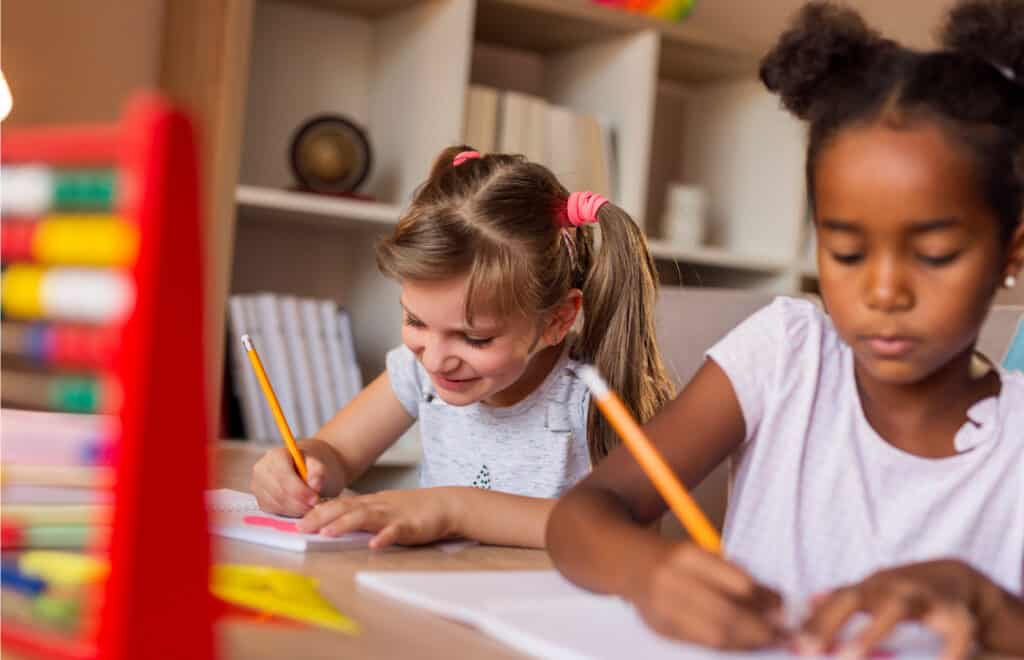
When students enjoy what they’re doing, they actively participate and learn more effectively. So, by adding captivating activities and games to elementary learning, we’re creating an environment where students are motivated, attentive, and eager to take on new challenges.
Vocabulary activities are a fun way for elementary students to learn and grow. When they engage in these activities, they get better with words and also become better at getting along with others and handling their feelings. These skills help them in school and in life.
The Wrap-Up: Classroom Vocabulary Activities
Incorporating vocabulary activities for elementary students into your teaching repertoire can be transformative for young minds.
Picture books, with their captivating narratives and eye-catching illustrations, serve as the perfect companions for classroom vocabulary activities.
And while they are known for helping young learners stave off the summer brain drain and prevent learning loss during breaks, picture books hold an even more profound power – they can ignite a lifelong passion for reading.
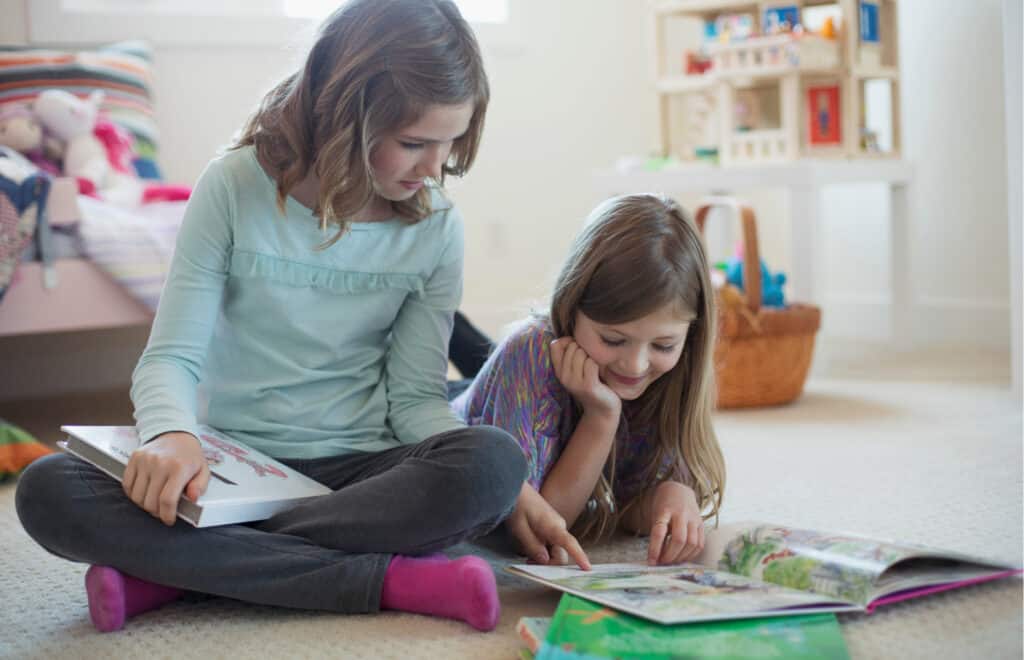
Let the magic of classroom vocabulary activities, coupled with the allure of picture books, guide your teaching approach and spark the flames of curiosity within your elementary students.
Keep your kids busy learning with the educational activities in these blogs:
11 Ways to Use Our Roll A Story Dice Game
13 Engaging Vocabulary Development Activities for Elementary Kids
Rebus Puzzles for Kids: A Comprehensive Riddle-Solving Guide
31 Fun Summer Reading Activities Elementary Students Will Love
The Best Neighborhood Walk Scavenger Hunt and 13 Different Ways to Use It
8 Easy Rebus Puzzles with Answers
Rebus Puzzles for Kids: A Comprehensive Riddle-Solving Guide
27 Educational YouTube Channels to Prevent Summer Learning Loss


